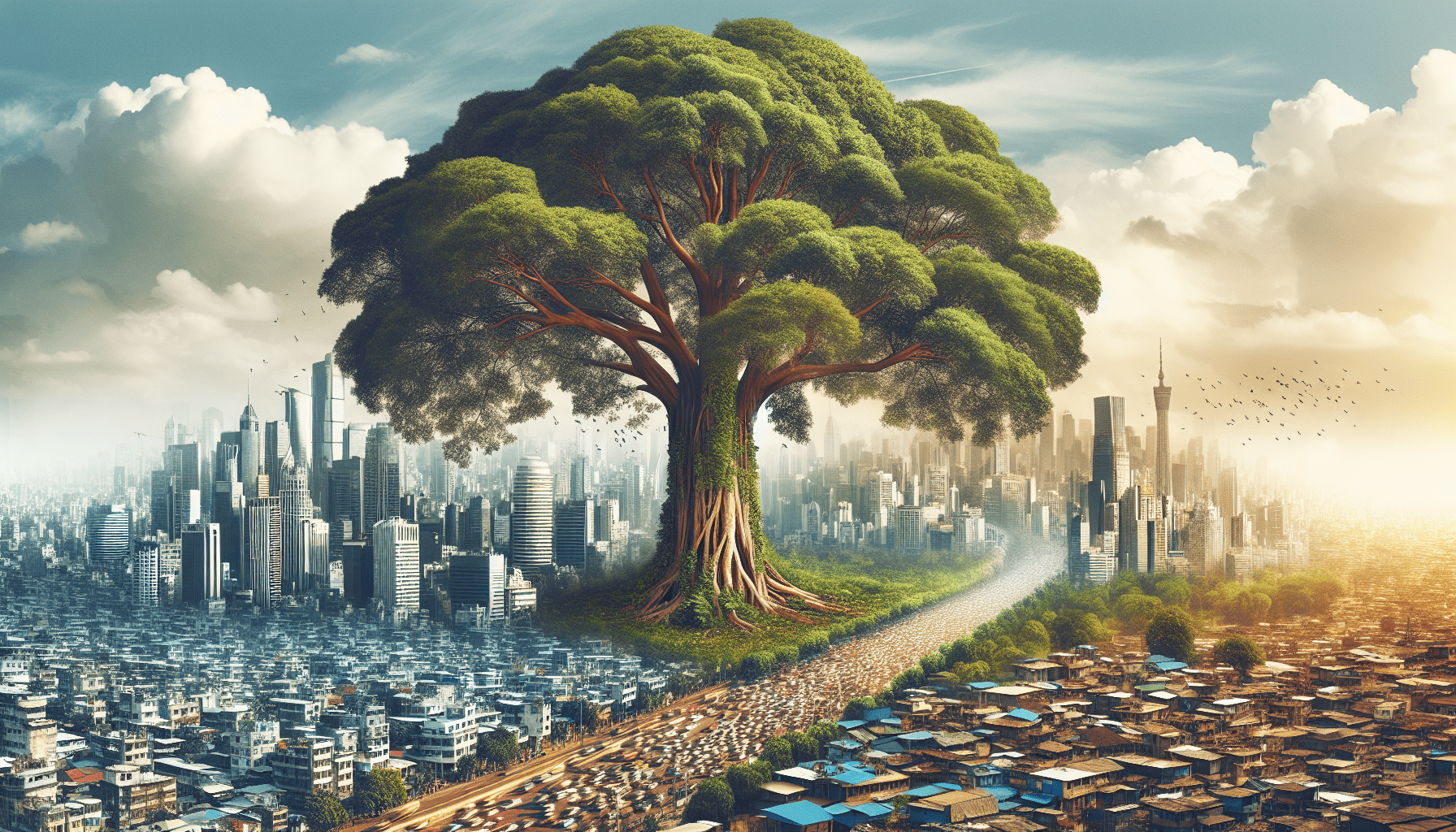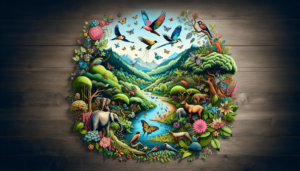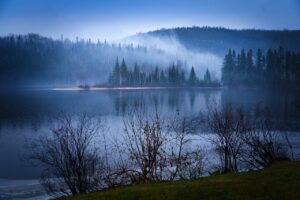Urbanization has become a defining feature of modern society, reshaping landscapes and transforming the way we live. As our cities grow and expand, it raises the question of how this rapid urban development impacts the rich tapestry of life on our planet. In this article, we explore the intricate relationship between urbanization and biodiversity, delving into the profound effects it has on the delicate balance of ecosystems. From loss of habitat to changes in species distribution, we uncover the ways in which urbanization shapes the natural world around us. Join us on this fascinating journey as we uncover the hidden impact of urbanization on biodiversity.
Habitat Loss
Urbanization has a significant impact on biodiversity, particularly through habitat loss. The clearing of forests and the conversion of land for human settlements and infrastructure is a major cause of habitat loss. Deforestation, the process of cutting down trees, not only results in the direct loss of habitat for countless species, but it also reduces the amount of carbon dioxide that can be absorbed, exacerbating climate change. Similarly, land conversion for urban development destroys natural habitats, which are vital for the survival of many plant and animal species. As a result, biodiversity is greatly compromised, and the delicate balance within ecosystems is disrupted.
Deforestation
Deforestation, driven primarily by the demand for agricultural land, timber, and urban expansion, is a prime driver of habitat loss. The removal of trees on a large scale has devastating consequences for both flora and fauna. Forests harbor a wide array of species, many of which are endemic and found nowhere else on Earth. From towering trees to unique understory plants, forests provide habitat and food sources for countless organisms.
How Does Urbanization Affect Biodiversity?
Land Conversion
Land conversion is another key contributor to habitat loss. As cities and towns expand, natural habitats such as grasslands, wetlands, and coastal areas are often converted into urban landscapes, agricultural fields, or industrial sites. This transformation results in the loss of critical habitats for numerous species, including birds, mammals, and reptiles. Wetlands, in particular, are highly productive ecosystems that support an incredible diversity of wildlife. When these areas are drained or filled in for development, the consequences for biodiversity are severe.
Fragmentation
The fragmentation of habitats is another consequence of urbanization, whereby large stretches of land are divided into smaller, isolated patches. This fragmentation can have detrimental effects on many species, as it disrupts migration patterns, limits access to resources like food and water, and increases the risk of predation. Species that require large areas to survive, such as large predators or migratory birds, are particularly vulnerable to habitat fragmentation. The loss of habitat connectivity can lead to a decrease in genetic diversity and an increased likelihood of local extinctions.
Pollution
As urban areas continue to expand, pollution becomes a major concern, with detrimental effects on biodiversity. Pollution comes in various forms, including air pollution, water pollution, and noise pollution. These pollutants can not only directly harm organisms but also disrupt ecological processes and alter ecosystems.
Air Pollution
Urban areas are notorious for their high levels of air pollution, largely due to vehicle emissions, industrial activity, and the burning of fossil fuels. The release of pollutants such as carbon dioxide, nitrogen dioxide, and particulate matter into the atmosphere can have harmful effects on both plants and animals. Air pollution can impair the respiratory systems of organisms, affect their reproductive capabilities, and even lead to genetic mutations. Additionally, smog and haze resulting from air pollution can reduce sunlight penetration and negatively impact plant growth.
Water Pollution
Urbanization often leads to the contamination of water bodies with pollutants such as plastics, chemicals, and sewage. Runoff from roads, driveways, and building sites can carry these pollutants into rivers, lakes, and oceans. Water pollution poses a serious threat to aquatic ecosystems, leading to the decline of fish populations, increased algal blooms, and the degradation of coral reefs. Species that rely on clean freshwater systems for survival, such as amphibians and fish, are particularly vulnerable to the impacts of water pollution.
Noise Pollution
Urban areas are characterized by constant noise from traffic, construction, and human activity. This noise pollution can create disturbances that affect the behavior and communication of many species. Prolonged exposure to high noise levels can disrupt feeding, reproduction, and even migratory patterns. For example, noise pollution can interfere with bird songs, making it difficult for them to attract mates or establish territories. Similarly, marine organisms, such as whales and dolphins, rely on sound for navigation and communication, and excessive noise can have serious consequences for their survival.
Introduction of Non-native Species
One of the lesser-known impacts of urbanization on biodiversity is the introduction of non-native or invasive species. These species, often unintentionally introduced by human activities, can have significant ecological and economic consequences. Non-native species can outcompete native species for resources, prey upon them, or introduce diseases to which native species have no resistance.
Competition
Non-native species can outcompete native species for limited resources such as food, water, and shelter. They may possess characteristics that give them a competitive advantage, allowing them to rapidly multiply and dominate ecosystems. This can lead to a decline in native species populations and even their local extinction. For example, invasive plants often grow vigorously and outcompete native plants, leading to a loss of biodiversity in plant communities.
Predation
Non-native species can also prey upon native species, leading to declines in their populations. In the absence of their natural predators, non-native predators can exploit native prey species without any checks on their population growth. This can have cascading effects on the entire ecosystem, disrupting the balance between predators and prey and altering food web dynamics. The introduction of rats or mongoose to islands is a classic example of the devastating impact of non-native predators on native bird populations.
Disease
The introduction of non-native species can also introduce new diseases or parasites to which native species have no immunity. These diseases can spread rapidly through naïve populations, leading to mass mortality and population crashes. For instance, the introduction of chytrid fungus to amphibian populations has caused catastrophic declines and extinctions of native frog species in many parts of the world.
Climate Change
Urbanization is intricately linked to climate change, with urban areas being major contributors to greenhouse gas emissions. Climate change poses numerous threats to biodiversity, affecting ecosystems and species in various ways.
Temperature Increases
Rising global temperatures as a result of climate change have profound implications for biodiversity. Many species are adapted to specific temperature ranges, and even slight increases in temperature can disrupt their physiological processes. Temperature increases can alter the timing of critical life events such as breeding, migration, and hibernation. For example, changes in temperature can mismatch the timing of bird nesting with the availability of food, resulting in reduced reproductive success.
Altered Rainfall Patterns
Climate change also affects rainfall patterns, leading to changes in the distribution and availability of water resources. Some regions may experience increased precipitation, while others may suffer from more frequent and severe droughts. These shifts can impact ecosystems by altering freshwater availability and affecting the growth and distribution of plant species. Water-dependent organisms, such as fish and amphibians, are highly vulnerable to changes in rainfall patterns, as they rely on specific water conditions for breeding and survival.
Extreme Weather Events
As the climate continues to change, extreme weather events such as hurricanes, heatwaves, and wildfires are becoming more frequent and intense. These events can have devastating effects on both ecosystems and the species that inhabit them. For instance, hurricanes can destroy habitats and displace wildlife, while heatwaves can cause mass mortalities in vulnerable populations. Additionally, the increased frequency of wildfires can lead to the loss of critical habitat and put many species at risk of extinction.
Reduced Genetic Diversity
Urbanization and its associated impacts can also lead to a reduction in genetic diversity within populations, making them more vulnerable to disease and other threats.
Inbreeding
Habitat fragmentation and the isolation of populations can increase the likelihood of inbreeding. When individuals from the same population mate with close relatives, it leads to reduced genetic diversity and an increased risk of genetic disorders. Inbreeding depression, as it is known, can weaken populations and reduce their ability to adapt to changing environmental conditions. In small and fragmented populations, inbreeding can become a significant concern, limiting their long-term viability and resilience.
Increased Vulnerability to Disease
Reduced genetic diversity can also make populations more susceptible to diseases and infections. Genetic diversity provides a source of variation that enables populations to adapt to new pathogens or environmental changes. When populations lack this diversity, they may have a limited ability to respond to diseases, increasing their vulnerability to outbreaks and epidemics. This can have disastrous consequences for species that are already under pressure from habitat loss and other forms of disturbance.
Disruption of Ecological Processes
Urbanization can disrupt key ecological processes that are essential for maintaining healthy ecosystems and supporting biodiversity.
Plant-Pollinator Relationships
Many plant species rely on pollinators such as bees, butterflies, and birds for reproduction. However, urbanization can disrupt these crucial plant-pollinator relationships. The loss of natural habitats and the decrease in floral resources in urban areas can result in a decline in pollinator populations. This, in turn, affects the pollination of plants, reducing their ability to reproduce and produce fruits and seeds. The loss of pollinators and the subsequent decline in plant diversity can have cascading effects on other organisms that depend on these plants for food and other resources.
Predator-Prey Interactions
Urbanization can disrupt predator-prey interactions, altering the delicate balance that exists within ecosystems. The loss of natural habitats and the fragmentation of landscapes can lead to changes in predator and prey densities and distributions. For example, the eradication of top predators such as wolves or large felines can result in a surge in prey populations. This can have ripple effects throughout the food chain, impacting the abundance and distribution of other species.
Food Web Dynamics
Disruptions to ecological processes can also affect the dynamics of entire food webs. A food web is a complex network of interactions among organisms that rely on each other for food resources. When certain species are lost or their populations decline due to urbanization, it can result in imbalances within the food web. The removal of key species, known as keystone species, can have disproportionate effects on the structure and function of ecosystems. For example, the loss of sea otters, a keystone species, has led to an explosion in sea urchin populations, which in turn has caused widespread destruction of kelp forests.
Loss of Ecosystem Services
Ecosystems provide a range of services that are essential for human well-being, known as ecosystem services. Urbanization and the associated impacts on biodiversity can lead to the loss of these important services.
Pollination
Pollinators such as bees and other insects play a crucial role in pollinating flowers and ensuring the reproduction of many plant species. This, in turn, results in the production of fruits, nuts, and other food crops that humans rely on. However, urbanization can lead to the decline of pollinator populations, reducing their ability to carry out this important ecosystem service. As a result, crop yields may decrease, affecting food production and the livelihoods of farmers.
Water Filtration
Natural ecosystems, such as wetlands and forests, play a vital role in filtering and purifying water. Wetlands, in particular, are excellent at removing pollutants and excess nutrients from water, improving its quality. However, urbanization often leads to the drainage or degradation of wetlands, reducing their capacity to effectively filter water. This poses challenges for urban areas in terms of accessing clean water and managing wastewater.
Climate Regulation
Ecosystems contribute to climate regulation through the absorption and storage of carbon dioxide, a greenhouse gas that contributes to climate change. Forests, for example, act as carbon sinks, helping to mitigate the impacts of rising carbon dioxide levels. However, deforestation and land conversion associated with urbanization release large amounts of stored carbon into the atmosphere, exacerbating climate change. Additionally, the loss of forests reduces the potential for carbon sequestration and compromises the ability of ecosystems to regulate local and regional climate patterns.
Human-Wildlife Conflict
As human activities encroach upon natural habitats, conflicts between humans and wildlife often arise. This conflict can take various forms, including crop raiding, predation on livestock, and threats to human safety.
Crop Raiding
Wildlife, driven by the loss of their natural habitats, may turn to agricultural fields and gardens in search of food. This can result in crop raiding, where wildlife, such as elephants, monkeys, or rodents, feed on crops, causing significant damage to livelihoods and food security. Crop raiding poses a challenge for farmers, who often resort to drastic measures to protect their crops, such as using deterrents or even resorting to the killing of wildlife.
Predation on Livestock
As natural habitats are lost, wildlife may come into closer proximity with livestock. This can result in predation on livestock, causing economic losses for farmers and ranchers. Predatory species such as wolves, coyotes, or big cats may kill or injure livestock, impacting the livelihoods of those who depend on them for their income. In response, farmers often resort to lethal control methods, further threatening the populations of these predator species.
Danger to Human Safety
As urban areas expand, they often overlap with areas that are home to large predators or other potentially dangerous wildlife species. This can pose risks to human safety, as encounters between humans and wildlife become more frequent. Attacks by wild animals, such as bears or large cats, can result in injuries or fatalities. As a result, efforts are made to manage and mitigate the risks associated with human-wildlife conflict, ensuring the safety of both humans and wildlife.
Effects on Indigenous and Endangered Species
Urbanization poses particular threats to indigenous and endangered species, which are often more vulnerable to habitat loss and disruption.
Decreased Population Size
Indigenous and endangered species are typically found in specific habitats, and as these habitats are destroyed or fragmented, their populations can decline rapidly. The loss of genetic diversity due to small population sizes further exacerbates the problem, making it difficult for these species to recover or adapt to changing conditions. The reduction in population size and genetic diversity puts indigenous and endangered species at a heightened risk of local extinction.
Loss of Habitat
Indigenous and endangered species rely on specific habitats for survival, and the destruction or alteration of these habitats can have severe consequences. Urbanization often leads to the loss of critical habitats such as rainforests, wetlands, and grasslands, which are home to many rare and unique species. When habitats are lost, there is often no suitable alternative for these species, leading to their decline or disappearance.
Increased Extinction Risk
The combination of habitat loss, reduced genetic diversity, and increased vulnerability to human activities puts indigenous and endangered species at a high risk of extinction. The loss of even a single species can have significant ecological and environmental consequences, disrupting the intricate web of interactions within ecosystems. Efforts are made to protect and conserve these species, often through the establishment of protected areas or captive breeding programs, but the challenges they face are significant.
Potential Solutions
While urbanization poses significant challenges to biodiversity, there are potential solutions that can help mitigate its impacts.
Urban Planning
Effective urban planning can play a crucial role in conserving biodiversity within urban areas. This includes designing cities and towns with nature in mind, incorporating green spaces, parks, and wildlife corridors. By considering the needs of both humans and wildlife in urban planning, it is possible to create sustainable, biodiverse urban environments. Additionally, measures such as green roofs and vertical gardens can help maximize green space in urban areas and provide habitat for plants and animals.
Green Infrastructure
Implementing green infrastructure solutions can have a positive impact on biodiversity. Green infrastructure involves using natural systems and processes to manage stormwater, reduce air pollution, and provide habitat for wildlife. Examples of green infrastructure include rain gardens, wetlands, and green roofs, which not only provide ecosystem services but also enhance urban biodiversity. By incorporating green infrastructure into urban design, it is possible to create more sustainable and resilient cities that support and protect biodiversity.
Conservation Education
Education and awareness regarding the importance of biodiversity and its conservation are crucial. By fostering an understanding of the interconnectedness of all living things and the value of biodiversity, individuals can make informed choices that contribute to its preservation. Conservation education can take various forms, from school programs and public outreach initiatives to community engagement and citizen science projects. By promoting a sense of stewardship and empowering individuals to take action, conservation education can be a powerful tool in mitigating the impacts of urbanization on biodiversity.
In conclusion, urbanization has profound effects on biodiversity, leading to habitat loss, pollution, the introduction of non-native species, climate change, reduced genetic diversity, disruption of ecological processes, loss of ecosystem services, human-wildlife conflict, and threats to indigenous and endangered species. Recognizing and understanding these impacts is crucial in order to develop effective strategies and solutions. By incorporating sustainable practices, promoting conservation education, and integrating biodiversity into urban planning, it is possible to create more resilient and biodiverse cities that support the coexistence of humans and wildlife.




